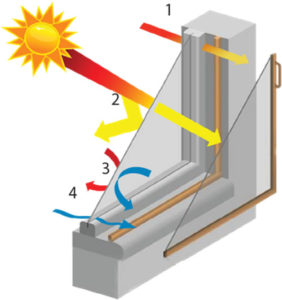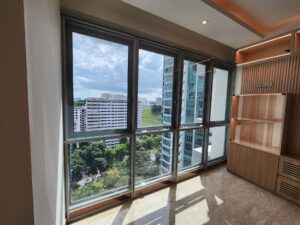Get ready for an epic karaoke night at home, where you and your pals can unleash your inner divas and rock stars without a care in the world. But hold on – you definitely don’t want the party to end with an irritated knock on the door from your neighbours, right? That’s where some clever acoustic and soundproofing aspects come into play.
By setting up the right measures to muffle the sound, you can sing your heart out and pump up the volume without fretting about noise complaints.
We’ve installed our Noise Shields for many clients’ windows for their home karaoke and entertainment areas, to help mitigate the sound travelling out, however, there’s more to consider!

We reached out to one of our industry partners, Fauzi Misdar, Project Consultant from JD Acoustics, to answer some questions and provide a more detailed look at considerations to make when setting up a home karaoke.
Q: Fauzi, what would you say are the 3 essential aspects that need to be considered when creating a home karaoke?

A: 1) Sound Insulation
2) Acoustic treatment
3) Equipment and Size of the room
Q: How to balance acoustics for sounding the best, and keeping sound leakage to the neighbours to a minimum?

A: Common misconception is to have acoustic panels installed and assume that the room is ‘Soundproof’.
To better understand this topic, it is best to separate into two categories, soundproofing and acoustic treatment:
Sound Insulation aka ‘Soundproof’
The main purpose for Sound Insulation is to reduce sound transmission from travelling from one room to another. That is the reason why we don’t call it soundproofing so as not to misinterpret it as 100% soundproof. A good example would be waterproofing, when we say we want to waterproof a toilet we will expect it to be 100% waterproofed. Where else for Sound insulation the main purpose is the ‘Reduce’ sound transmission.
We have to understand the 2 types of noise transmission
Airborne Noise
This type of noise is transmitted by air and atmosphere such as music, traffic noise and people talking. When sound waves travelling through the air reach a building element they hit it and cause it to vibrate. These vibrations travel through the structure or building and are radiated out the other side. Have you ever been inside of your quiet home as a karaoke takes place next door or even opposite a building? It may have felt as if the music was reverberating loudly within your house. This is due to airborne noise traveling through windows and doors which are a major source of sound leakage.
Structure-borne Noise
Structure-borne noises are transmitted when sound arises from the actual impact of an object on a building element such as a wall, floor or ceiling. For example, say you live below someone else in an apartment complex or you live in a two-story house. Whenever you hear someone’s footsteps above you, you’re hearing structure-borne noise. Structure-borne sound occurs because the impact causes both sides of the building element to vibrate, generating sound waves. Even speaker subwoofers can cause structure-borne noise. This can oftentimes be the hardest to isolate.
Solution
The ideal solution is to build what we call room within a room. It basically means to build another set of rooms in the existing room. The only difference is that the newly erected wall, ceiling and floor have to be decoupled by using anti vibration. There are a few steps that are required, to name a few: Damping, adding mass density, and absorption. This is the proper and ideal way of approaching noise related issues. Although room within a room is an ideal solution, we also do understand that especially in Singapore, where residential space is considered a luxury, this might not be possibe. We also provide alternative solutions, such as only treating areas that are affected. For a KTV room it really depends on what equipment you have. For example, if you don’t have a subwoofer, you might consider just treating the ‘airborne noise’ of the affected area.
Even though this is not ideal as there are other flanking noise transmission paths. It is still better than to not have any treatment at all.
Acoustic Treatment
Acoustic panels are solutions that help to absorb or diffuse sound to improve the acoustic quality of a space. These treatments come in various forms, and some facilities may need multiple types of treatments to achieve the ideal acoustics for the space.
To take a KTV room for example, we wouldn’t want to have full absorption all around and make the room sound ‘dead’. Would be ideal to have a mixture of absorption and diffusion so as to achieve a much better spectrum in terms of sound experience. For a recording studio on the other hand, usually the room is quite ‘dead’ and more focused which is ideal for recording.
Solution
I would highly recommend the desired KTV room to be tested. As long as the room is enclosed, we are able to do a RT60 test. Reverberation in a room/space is measured by Reverberation Time which measures the decay time of an impulse noise. A Reverberation Time of 1 second means that it takes 1 seconds for a sound/noise to completely die down. Imagine in a long sentence, this will cause a problem as before the first word completely dies down, the subsequent words will come and get jumbled up together.
Not all rooms are the same. Depending on the size of the room, and what are the materials in the room. For example, carpet finishing, sofa, hard furniture, brick wall or drywall. All of these details play a part in acoustic treatment.
Q: Does equipment placement play a role?

A: Yes it does.
Here’s the thing, the majority would want to have the best KTV equipment set up for their home. Some go to the extent to even have 2 sets of subwoofers and multiple speakers. The thing is – the room size and speaker placement is important, too. Especially with a small space when the room is ‘squarish’ the room will naturally have low frequency issues related to room modes.
The best is to have the speaker placed towards a longer part of the room for better sound projection. Both Acoustic and Equipment are relatively important and will have to come hand in hand. The key is to have a balance of both.
Q: Is there a good way to reduce base vibration traveling through the floor or walls?

A: Yes. As mentioned previously above for Sound Insulation.
Have you ever experienced your neighbour doing some drilling work and you can hear the noise? Even if your residential unit is 5 storeys apart? That is structural vibration, especially Residential condo and HDB. The building Structure is shared amongst other units.
The best way is to build a room within a room. The only difference is that the newly erected wall, ceiling and floor have to be decoupled by using anti vibration. There are a few steps that are required, to name a few: Damping, adding mass density, and absorption. This is the proper and ideal way of approaching noise related issues.
Q: What are your conclusions?

A: Ideally is to have the room isolated from the main structure by building wall, ceiling and floor insulation. To have acoustic doors and windows. Lastly acoustic panels to be placed strategically.
In conclusion, creating a home karaoke setup involves three key elements: sound insulation, acoustic treatment, and equipment placement. To minimize sound leakage and ensure good sound quality, it’s important to understand the distinction between sound insulation and soundproofing. Sound insulation helps reduce airborne and structure-borne noise transmission, while acoustic treatment, like using a mix of absorption and diffusion panels, enhances the room’s sound quality without making it too dull. Proper equipment placement, particularly in smaller spaces, can help optimize sound projection and minimize low-frequency issues. By balancing these aspects, you can enjoy an immersive karaoke experience without disturbing your neighbours.
With our thanks to
Fauzi Misdar
Project Consultant
JD Acoustic Pte Ltd
3 Ang Mo Kio Street 62 #03-22/27 Link @AMK Singapore 569139
Email: fauzi@jdacoustic.com
Website: www.jdacoustic.com



